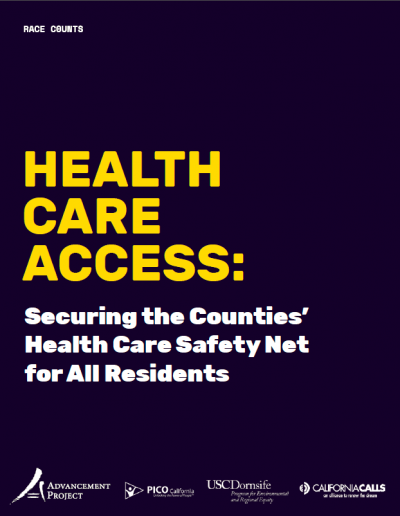Despite the significant gains in terms of health coverage, access, and utilization made since implementation of the Affordable Care Act (ACA), racial health disparity remains omnipresent in California. While a radical force for change in many respects, the ACA’s reforms were largely built atop our pre-existing health care system, inheriting its disparities. Because health disparity drivers abound in and outside our health care system – undermining our state’s well-being – agents advancing health equity become even more vital.
Key Findings
- The ACA helped increase capacity at community health centers
- Improved health care access was important in driving down the rate of preventable hospital stays – a highly-disparate and costly event – for people of color in California
- Black, Latinx, and American Indian/Alaska Native Californians continue to struggle with health care access and outcome disparities even after ACA implementation
- The level of support that California counties lend their individual safety net programs is fundamental in a statewide pursuit of health equity
Report Recommendations
Counties should prioritize their health safety nets
As our analysis has shown, in too many cases, counties have been content to coast, allowing state and federal programs (and dollars) to play the near-exclusive role in determining access for their residents. County leaders should listen to advocates’ arguments that there is a local stake in health equity too.
Counties should make a concerted effort to make sure that their safety nets live up to their names. At a basic level, this will require additional resources – and beyond looking to leverage state and federal funding and grant opportunities, counties should commit significant local resources, including property tax revenues. Funds should be allocated after a needs-assessment determines which investments would do most to ameliorate the specific racial disparities in each county. Those counties that have already created promising programs in this regard should loosen restrictive income eligibility standards to make those benefits more widely available to vulnerable residents.
Counties also should think broadly about how to address social determinants of health, understanding that effective access has many prerequisites and that low-income communities of color often labor under the burden of multiple, simultaneous disparities.
Set a framework to guarantee health care access for all
Counties will need support and partnership from Sacramento to achieve health equity goals. First, the state should set a floor by creating a baseline standard requiring that every Californian receive primary care. This would involve a concomitant requirement that county programs extend eligibility regardless of immigration status. It would also mean the adoption of uniform standards for data and reporting, for both demographic and outcome data, to enable regulators and researchers to understand whether counties are meeting this requirement.
Secondly, to allow even resource-poor counties to meet the goal, the state should adopt new funding allocation metrics to ensure that dollars are following need. Ensuring adequacy of funding might require the state to revisit how its budgets allocate existing health funding streams, such as the recently-passed Propositions 52 and 56, and explore new ones. Ultimately, the state should lead the way toward universal coverage. Until then, steps such as extending full-scope Medi-Cal coverage to all state residents, would go far toward reducing the disparities we have identified, and provide an important backstop to counties that lack the funding or political will to take on these challenges.
Create incentives to widen the health care workforce pipeline for areas in need
The current workforce systems, in conjunction with local job market conditions across California, make it difficult for safety net providers in underserved areas in either rural or urban counties to develop, attract and retain a sufficient number of trained, culturally-competent health professionals. It is low-income communities of color, especially those with language needs, who are locked out as a result. Educational training and incentives such as loan forgiveness can help open avenues for historically-disadvantaged populations to enter a broad array of health professions and encourage them to remain working locally.
While federal action may ultimately be required and while waiting for more supportive federal partners, the state’s new Future Health Workforce Commission can lead the way by studying the gaps in existing programs such as the Teaching Health Center program and the National Health Services Corps, and identifying potential state-level solutions.
Improve data-gathering and analysis
Important gaps in the available health care access data remain – limiting the ability of advocates and leaders to improve our public systems. To help all stakeholders better understand the challenges and opportunities before them, we call on agencies that create and gather public health data to adopt the following best practices:
- collect and make available data disaggregated by race, ethnicity, and national origin wherever possible, especially for the Asian American community;
- prioritize data collection efforts to ensure that there is comprehensive, accurate information about the state of health access in Indigenous communities;
- gather data about the experience, access, and outcomes of immigrants in our health systems, while being mindful of the potential for harm and distrust if questions are not asked appropriately; and
- institute uniform data collection and reporting protocols for each county’s safety net program that abide by the above recommendations.
